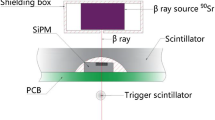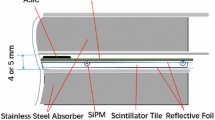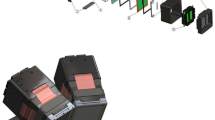Abstract
The Circular Electron Positron Collider (CEPC) project is a Higgs/Z factory proposed by Chinese high energy physics community. A fine granular scintillator-tungsten electromagnetic calorimeter (ScW ECAL) is under development for the application of the particle flow algorithm (PFA) at CEPC. The active layers of the ScW ECAL are consisting of 5 × 45 mm2 plastic scintillator strips, with silicon photomultiplier (SiPM) readout. A set of ScW ECAL geometries has been implemented into the Geant4 simulation to optimize the geometry parameters such as layer numbers and scintillator sensor thickness. The performances of SiPM and the scintillator strip detector were tested, and the test results indicate that the SiPM and the sensor detector worked well. These results are meaningful for the construction and the tests of the prototype at the next stage.
Access provided by CONRICYT-eBooks. Download conference paper PDF
Similar content being viewed by others
Keywords
1 Introduction
The CEPC [1] project, which is proposed by Chinese high energy physics community, is preliminarily designed as a Higgs/Z factory to boost the precision of Higgs properties and SM measurements. By using PFAs [2], together with a detector system that is optimized for the PFAs’ application, a full spectrum of physics objects can be reconstructed with great efficiency and precision for the physics program at CEPC. The PFA requires calorimeters having the capability of separation from individual particles in jets, and consequently requires fine-segmented calorimeters. With the recent development of SiPM, the plastic scintillator technique can provide such a small and feasible unit of detectors. A fine granular scintillator-tungsten ECAL, which consists of plastic scintillator detector as active sensor and tungsten plate as absorber, is considered by CEPC collaboration. The plastic scintillator is designed as strip shape and aligned orthogonally in adjacent layers to provide effective granularity close to the strip width while the number of channels can be reduced by an order of magnitude.
In this paper, we describe the results of ScW ECAL performance study with Geant4 [3] simulation and sensor detector test. In Sect. 2, the Geant4 simulation results of the photon intrinsic energy resolution with different layer number and scintillator sensor thickness are compared. In Sect. 3, the performance of the SiPM is shown. And the test result of scintillator strip sensor is shown in Sect. 4.
2 Simulation of Geometry Parameter
Using simulated single photon samples, the intrinsic photon energy resolutions at different ECAL layer number and scintillator sensor thickness were studied.
When changing the layer number in ScW ECAL simulation, the total thickness of absorber layers should remain the same to maintain the leakage of electromagnetic showers. Figure 1 shows the intrinsic photon energy resolution when the layer number is 30, 25, and 20, while the total thickness of absorber is 84 mm and the thickness of scintillator sensor in each layer is 2 mm. The energy resolution gets worse if the layer number was reduced, because of the lower sampling ratio.
Figure 2 shows the photon energy resolution with 1 mm, 2 mm, and 3 mm thick scintillator sensor in each of the 30 layers, while the thickness of tungsten plates remains 2.8 mm. As expected, the energy resolution becomes better with the thicker sensor.
3 SiPM Performance Study
The SiPM is a novel semiconducting photon counting device manufactured by Hamamatsu Photonics K.K. [4]. As the pulse spectra shown in Fig. 3, the individual peaks are clearly separated from each other, which proves excellent photon counting ability of the SiPM.
Because each pixel on a SiPM can only detect one photon at once and a few nanoseconds are needed before recovery, the SiPM is not a linear photon detection device, especially when the input light intensity is strong. The application of CEPC ScW ECAL is a challenge to the dynamic range of SiPM, and the study of the response is necessary. For a short time light pulse, the response of the SiPM can be theoretically calculated as
However, for the ScW ECAL, the width of the light pulse should not be ignored, and some pixels of SiPM can detect more than one photon in an event. The response of the SiPM should be modified as
The Neff stands for the effective number of pixels on a SiPM, which is relative to the width of the input light pulse. A dynamic range test result with 1600-pixel SiPM is shown in Fig. 4. Further tests are needed for the SiPM with more pixels.
The response curve of 1600-pixel SiPM. The black points are test results; the red curve is the fit result with Eq. (2); the blue line is the ideal linear result.
4 Scintillator Strip Test
Because the SiPM is coupled at one end of the scintillator strip, the signal readout by SiPM will not be homogeneous, which will affect the performance of the ScW ECAL. Figure 5 shows the test result of the light pulse height readout by the SiPM when the \( \upbeta \) ray from a Sr90 source hit at different positions of the scintillator strip. The result shows that the non-homogeneity of the scintillator detector is 23%.
5 Summary and Plan
In this paper, we show the results of the performance study of the ScW ECAL, including the simulation results at different geometry parameters and the performance test results of the SiPM and the scintillator strip sensor. The optimization and performance study will be carried on more deeply. A prototype of ScW ECAL is also planned to be constructed and tested.
References
CEPC Homepage. http://cepc.ihep.ac.cn/index.html
Thomson, M.: Particle flow calorimetry and the PandoraPFA algorithm. Nucl. Instrum. Methods A 611, 25–40 (2009). arXiv:0907.3577 [physics.ins-det]
The GEANT4 Collaboration, Agostinelli, S., et al.: GEANT4: a simulation toolkit. Nucl. Instrum. Methods A 506, 250–303 (2003)
Hamamatsu Photonics K.K. Homepage. http://www.hamamatsu.com/index.html
Acknowledgements
This research programme has been partially supported by National Key Programme for S&T Research and Development (Grant NO. 2016YFA0400400), the CEPC Innovative project of IHEP, the National Natural Science Foundation of China (Grant NO. 11675196, NO. 11175198, NO. 11475209 and NO. 11675205), and the Strategic Priority Research Program of the Chinese Academy of Sciences (Grant NO. XDA10010400).
Author information
Authors and Affiliations
Corresponding author
Editor information
Editors and Affiliations
Rights and permissions
Copyright information
© 2018 Springer Nature Singapore Pte Ltd.
About this paper
Cite this paper
Zhao, H. et al. (2018). Performance Study for the CEPC ScW ECAL. In: Liu, ZA. (eds) Proceedings of International Conference on Technology and Instrumentation in Particle Physics 2017. TIPP 2017. Springer Proceedings in Physics, vol 213. Springer, Singapore. https://doi.org/10.1007/978-981-13-1316-5_3
Download citation
DOI: https://doi.org/10.1007/978-981-13-1316-5_3
Published:
Publisher Name: Springer, Singapore
Print ISBN: 978-981-13-1315-8
Online ISBN: 978-981-13-1316-5
eBook Packages: Physics and AstronomyPhysics and Astronomy (R0)









